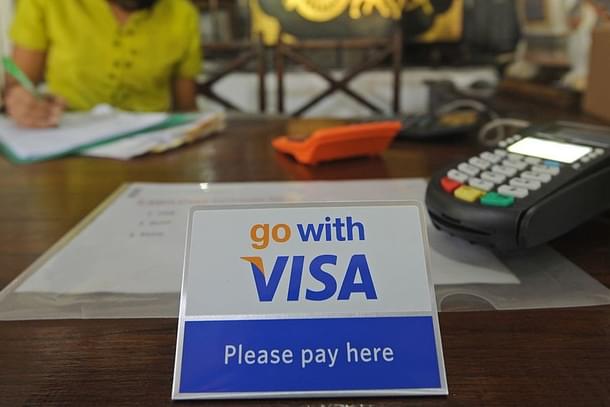Business
Visa’s Meltdown Shows Why India Must Invest In Capacity Building
Tushar Gupta
Nov 29, 2021, 07:54 PM | Updated 07:54 PM IST
Save & read from anywhere!
Bookmark stories for easy access on any device or the Swarajya app.


Several reports have confirmed that payments giant Visa Inc has formally registered a complaint with the United States government stating that the government of India’s ‘formal and informal’ endorsement of local rival RuPay is denting the prospects of the company in the world’s biggest free market. Visa raised the complaint about the lack of a level playing field in India’s payments market during a meeting with US Trade Representative Katherine Tai.
For Visa, losing out on growth opportunities in India represents a worrying sign. India’s age of cashless payments has barely begun. In the midst of the global pandemic, India registered the highest number of online transactions across 2020, exceeding 25 billion. China, even with all its superapps and more than a billion internet users, was a distant second with 15-billion odd online transactions.
Visa’s meltdown before the US Trade Representative is a reminder for the government in capacity building. The key driver for the staggering scale of digital payments in India has been the cheap internet, ushered by the local Reliance Jio, and the payment infrastructure, created under the purview of the National Payments Corporation of India (NPCI). To complement the work done by NPCI with the United Payments Interface (UPI) ecosystem, there was the Jan Dhan Yojana, ensuring financial inclusion for more than 400 million people.
For the future, it would be hard for the likes of Visa to keep up in India for a few reasons. Firstly, debit cards, as a concept, are beginning to become primitive. With people moving to payments via UPI on their mobile phones for retail shopping, the routine application of debit cards will only lose steam from here. The UPI success presents an ideal case study for this.
Continuing its upward trajectory, the Unified Payments Interface (UPI) clocked 4.22 billion transactions in the month of October 2020, registering an increase from 3.66 billion transactions in the preceding month.
From 21 banks, and 0.09 million transactions and Rs. 0.38 crore in transaction value in July 2016, to 261 banks, and more than 4.2 billion transactions, and more than Rs. 7.71 lakh crore transaction value today, UPI, as a payment interface, has come a long way, and yet, it is far from peaking and could well witness 50 billion transactions in volume by 2026.
Clocking 50 billion transactions per month, for UPI, within the next five years, is no arduous task. Assuming a billion internet users, each making 50 transactions per month on an average, is quite simple.
For instance, a simple street vendor can register 100 transactions on a daily basis through UPI in pockets of Bengaluru, Noida, and Pune today. In many supermarkets, 50-100 transactions through any UPI platform is a routine affair. Thus, it is something that will scale naturally, and the biggest industries that will enable this growth would be FMCG in retail and food and beverages.
With an ecosystem sprawling 50 billion transactions and more than 250 banks in 2026, card payments are set to decline, almost being rendered obsolete. There is also the convenience, security, and lack of paperwork that makes UPI payments a preferred option amongst the masses.
Two, the problem of data localisation. Earlier this year, in July, the Central Bank banned Mastercard, one of the other key players in the card markets from issuing new cards due to non-compliance with the data localisation requirements. Many banks, for instance, the RBL Bank, had to move away from Mastercard to Visa or RuPay, for issuing new cards.
Data Localisation is critical to India’s long-term interests, without a doubt, and in the pursuit of it, if the government chooses to opt for RuPay debit cards over Visa or Mastercard, it can hardly be blamed. Today, more than 55 per cent of the debit card market in India is controlled by state-owned or public-sector banks, and thus, RuPay gains further advantage.
Even with Jan Dhan Yojana, with more than 430 million bank accounts, and close to 300 million RuPay cards issued, the data localisation problem is solved to a great extent. Imagine the scenario if the entire market of digital payments in India was centered only around debit and credit cards, and with only Visa and Mastercard, without UPI or RuPay. In the long run, it would have been a data privacy, protection, and localisation nightmare.
Three, for Visa and its foreign counterparts, a shift away from credit cards, that warrant paperwork and physical verification, to pay-later applications, micro-financing options, and other micro-lending apps that work on minimal paperwork and verification, all digital though, creates an existential crisis. Even if the private banks could stress on debit cards by Visa for its customers, what good are the credit cards going forward?
The account aggregator framework is already underway to further aid the scale and growth of microlending across India without the need of credit cards that come with an exuberant interest rate. The aggregators, which will be licensed by the Reserve Bank of India (RBI), will be critical in bridging the credit gap between financial lenders and millions of borrowers in India with limited or lack of credit history. They will be structured as non-banking financial companies.
Visa is not alien to these changing realities on the ground. As early as 2017, it was lobbying the government for permission to create more payment products as UPI began to gain prominence. Sensing the scale which UPI could attain in the next five years, Visa and its counterparts tried hard to cash in on the opportunity, pitching ideas around QR codes and cashless payments.
Visa’s meltdown is both a lesson and a reminder for India- to invest in capacity building and not stop. While the digital payments infrastructure is merely one of the many aspects the government must invest in from a capacity building perspective, it should draw a lesson from the helplessness of this Western corporation and accelerate its pursuit of Atmanirbhar Bharat in everything, from social media to semiconductors.
Tushar is a senior-sub-editor at Swarajya. He tweets at @Tushar15_





